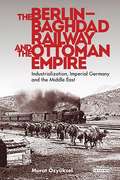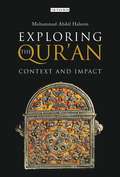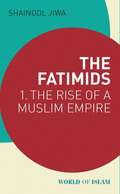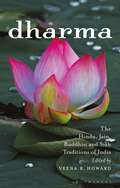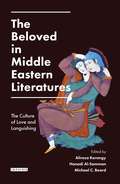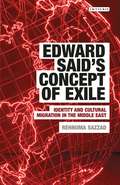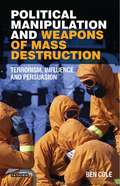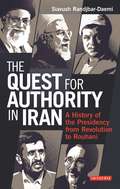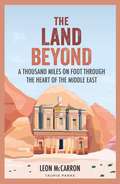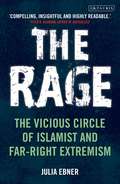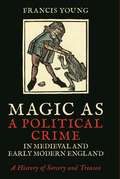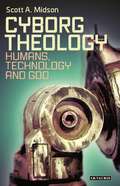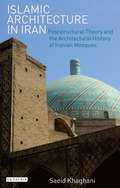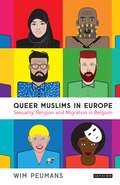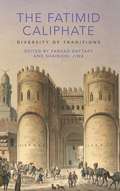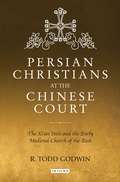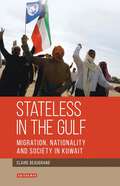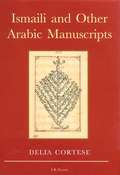- Table View
- List View
Sofia Coppola: A Cinema of Girlhood (International Library of the Moving Image (PDF))
by Fiona HandysideSofia Coppola is widely regarded as one of the most astute, provocative and visionary directors in the contemporary film industry. She has received numerous accolades including an Academy Award and two Golden Globes, and in 2004 became the first ever American woman to be nominated for a Best Director Oscar. From The Virgin Suicides to The Bling Ring, her work carves out new spaces for the expression of female subjectivity that embraces rather than rejects femininity. Fiona Handyside here considers the careful counter-balance of vulnerability with the possibilities and pleasures of being female in Coppola's films – albeit for the white and the privileged – through their recurrent themes of girlhood, fame, power, sex and celebrity. Chapters reveal a post-feminist aesthetic that offers sustained, intimate engagements with female characters. These characters inhabit luminous worlds of girlish adornments, light and sparkle and yet find homes in unexpected places from hotels to swimming pools, palaces to strip clubs: resisting stereotypes and the ordinary. In this original study, Handyside brings critical attention to a rare female auteur and in so doing contributes to important analyses of post-feminism, authorship in film, and the growing field of girlhood studies.
The Berlin-Baghdad Railway and the Ottoman Empire: Industrialization, Imperial Germany and the Middle East (Library of Ottoman Studies)
by Murat ÖzyükselRailway expansion was the great industrial project of the late 19th century, and the Great Powers built railways at speed and reaped great commercial benefits. The greatest imperial dream of all was to connect the might of Europe to the potential riches of the Middle East and the Ottoman Empire. In 1903 Imperial Germany, under Kaiser Wilhelm II, began to construct a railway which would connect Berlin to the Ottoman city of Baghdad, and project German power all the way to the Persian Gulf. The Ottoman Emperor, Abdul Hamid II, meanwhile, saw the railway as a means to bolster crumbling Ottoman control of Arabia. Using new Ottoman Turkish sources, Murat Özyüksel shows how the Berlin-Baghdad railway became a symbol of both rising European power and declining Ottoman fortunes. It marks a new and important contribution to our understanding of the geopolitics of the Middle East before World War I, and will be essential reading for students of empire, Industrial History and Ottoman Studies.
Exploring the Qur'an: Context and Impact
by Muhammad Abdel HaleemThe teachings, style and impact of the Qur'an have always been matters of controversy, among both Muslims and non-Muslims. But in a modern context of intercultural sensitivity, what the Qur'an says and means are perhaps more urgent questions than ever before. This major new book by one of the world's finest Islamic scholars responds to that urgency. Building on his earlier groundbreaking work, the author challenges misinterpretations of particular Qur'anic verses from whatever quarter. The author argues that wrenching the verses out of the context of the whole has led to dangerous ideologies being built on isolated phrases which have then assumed afterlives of their own. This nuanced, holistic reading has vital interfaith ramifications.
The Fatimids: 1 - The Rise of a Muslim Empire (World of Islam)
by Shainool JiwaEmerging from a period of long seclusion, in the year 909 the leader of the burgeoning community of Ismaili Shi'i Muslims was declared the first Fatimid Imam-caliph. Abd Allah al-Mahdi founded the only sustained Shi'i dynasty (909–1171) to rule over substantial parts of the medieval Muslim world, rivalling both the Umayyads of Spain and the Abbasids. At its peak, the Fatimid Empire extended from the Atlantic shores of North Africa, across the southern Mediterranean and down both sides of the Red Sea, covering also Mecca and Medina. This accessible history, the first of two volumes, tells the story of the birth and expansion of the Fatimid Empire in the tenth century. Drawing upon recently available eyewitness accounts, Shainool Jiwa introduces the first four generations of Fatimid Imam-caliphs - al-Mahdi, al-Qa'im, al-Mansur and al-Mu'izz - as well as the people who served them and those they struggled against. Readers are taken on a journey through the Fatimid capitals of Qayrawan, Mahdiyya and Mansuriyya and on to the founding of Cairo. In this lively and comprehensive introduction, we discover various milestones in Fatimid history and the political and cultural achievements that continue to resonate today.
The History of a Modern Millennial Movement: The Southcottians (I.B.Tauris Studies in Prophecy, Apocalypse and Millennialism #20170530)
by Jane Shaw Philip LockleyA feverish expectation of the end of the world seems an unlikely accompaniment to middle-class respectability. But it was precisely her interest in millennial thinking that led Jane Shaw to a group of genteel terraced townhouses in the English county town of Bedford. Inside their unassuming grey-brick exteriors Shaw found something extraordinary. For here, within the 'Ark', lived two members of the Panacea Society, last survivors of the remaining Southcottian prophetic communities in Britain. And these individuals were the heirs to a rich archive charting not just their own apocalyptic sect, but also the histories of the many groups and their leaders who from the early nineteenth century onwards had followed the beliefs of the self-styled prophetess and prospective mother of the Messiah ('Shiloh'), Joanna Southcott, who died in 1814. Placing its subjects in a global context, this is the first book to explore the religious thinking of all the Southcottians. It reveals a transnational movement with striking and innovative ideas: not just about prophecy and the coming apocalypse, but also about politics, gender, class and authority.
Dharma: The Hindu, Jain, Buddhist and Sikh Traditions of India (Library of Modern Religion)
by Veena R. HowardDharma is central to all the major religious traditions which originated on the Indian subcontinent. Such is its importance that these traditions cannot adequately be understood apart from it. Often translated as “ethics,” “religion,” “law,” or “social order,” dharma possesses elements of each of these but is not confined to any single category familiar to Western thought. Neither is it the straightforward equivalent of what many in the West might usually consider to be “a philosophy”. This much-needed analysis of the history and heritage of dharma shows that it is instead a multi-faceted religious force, or paradigm, that has defined and that continues to shape the different cultures and civilizations of South Asia in a whole multitude of forms, organizing many aspects of life. Experts in the fields of Hindu, Jain, Buddhist and Sikh studies here bring fresh insights to dharma in terms both of its distinctiveness and its commonality as these are expressed across, and between, the several religions of the subcontinent. Exploring ethics, practice, history and social and gender issues, the contributors engage critically with some prevalent and often problematic interpretations of dharma, and point to new ways of appreciating these traditions in a manner that is appropriate to and thoroughly consistent with their varied internal debates, practices and self-representations.
A Short History of Medieval Christianity (I.B.Tauris Short Histories)
by G.R. EvansWhat did people really believe in the Middle Ages? Much of our sense of the medieval period has come down to us from the writings of the learned: the abbots, priors, magnates, scholastic theologians and others who between them, and across Christendom, controlled the machinery of church and state. For G R Evans too much emphasis has been placed on a governing elite and too little on those – the great mass of the semi-literate and illiterate, and the emergent middle classes – who stood outside the innermost circles of ecclesiastical power, privilege and education. Her book finally gives proper weight to the neglected literature of demotic religion: the lives of saints; writings by those – including lay women – who had mystical experiences; and lively texts containing stories for popular edification. Ranging widely, from the fall of Rome to the ideas of the Reformation, the author addresses vital topics like the appeal of monasticism, the lure of the Crusades, the rise of the friars and the acute crisis of heresy. As Evans reveals, medieval Christianity was shaped above all by its promise of salvation or eternal perdition.
The Beloved in Middle Eastern Literatures: The Culture of Love and Languishing (Library of Middle East History)
by Alireza Korangy Hanadi Al-Samman Michael BeardIn the long literary history of the Middle East, the notion of 'the beloved' has been a central trope in both the poetry and prose of the region. This book explores the concept of the beloved in a cross-cultural and interdisciplinary manner, revealing how shared ideas on the subject supersede geographical and temporal boundaries, and ideas of nationhood. The book considers the beloved in its classical, modern and postmodern manifestations, taking into account the different sexual orientations and forms of desire expressed. From the pre-Islamic 'Udhri (romantic unrequited love), to the erotic same-sex love in thirteenth century poetry and prose, the divine Sufi reflections on the topic, and post-revolutionary love encounters in Iran, Egypt and Saudi Arabia, The Beloved in Middle Eastern Literatures connects the affective and cultural with the political and the obscene. In focusing on the diverse manifestations of love and tropes of the lover/beloved binary, this book is unique in foregrounding what is often regarded as a 'taboo subject' in the region. The multi-faceted outlook reveals the variety of philological, philosophical, poetic and literary forms that treat this significant motif.
Contested Spaces in Contemporary Turkey: Environmental, Urban and Secular Politics (Library of Modern Turkey)
by Fatma Müge GöçekThe most significant political development of the post-Cold War era was, arguably, the diffusion of neoliberalism across the globe. Yet behind the illusion of abundance and development, the 'rule of the market' can be violent and destructive, exploiting the environment, dismissing cultural or historical conservation and ignoring individual rights. This book now examines the emergence and consequences of neoliberalism in Turkey. Of particular importance to the study are the contested spaces - those sites of struggle and protest - where the impact of this economic system is challenged or negotiated. The contributors look beyond the neoliberal cities of the West - Istanbul and Ankara - to take into account the rest of the country and the groups that are most negatively affected: such as the Kurds, women and migrants. Chapters consider the complexity of neoliberalism in Turkey, where the power of the market, the agenda of the state, and significantly, the country's past, are shown to have shaped current economic practices and policies. Contested Spaces in Contemporary Turkey sheds new light on the societal processes that are re-shaping modern Turkey, a subject which is of increasing importance considering Erdogan's new model for an Islam-based state and in the aftermath of the July 2016 military coup attempt. It is at the cutting edge of research on urban history and social space and will be a significant resource for scholars of Turkish Studies and Kurdish Studies.
Indian Muslim Minorities and the 1857 Rebellion: Religion, Rebels and Jihad (International Library of Colonial History)
by Ilyse R. FuerstWhile jihad has been the subject of countless studies in the wake of recent terrorist attacks, scholarship on the topic has so far paid little attention to South Asian Islam and, more specifically, its place in South Asian history.
Destroying a Nation: The Civil War in Syria
by Nikolaos Van DamFollowing the Arab Spring, Syria descended into civil and sectarian conflict. It has since become a fractured warzone which operates as a breeding ground for new terrorist movements including ISIS as well as the root cause of the greatest refugee crisis in modern history. In this book, former Special Envoy of the Netherlands to Syria Nikolaos van Dam explains the recent history of Syria, covering the growing disenchantment with the Assad regime, the chaos of civil war and the fractures which led to the rise and expansion of ISIS. Through an in-depth examination of the role of sectarian, regional and tribal loyalties in Syria, van Dam traces political developments within the Assad regime and the military and civilian power elite from the Arab Spring to the present day.
On the Religious Frontier: Tsarist Russia and Islam in the Caucasus (International Library of Historical Studies)
by Firouzeh MostashariModern Russia's turbulent relations with its Muslim frontiers date back centuries. Indeed the nineteenth century, when the Muslim Caucasus first came under Russian rule, witnessed many of the historical antecedents to today's violent confrontations. With this in mind, On The Religious Frontier examines the history of Muslim Azerbaijan under Christian Orthodox Russian imperial rule and the attempts of the Russian administrators of the Caucasus to integrate the region into the empire. Drawing on original archival research from across Azerbaijan and Russia, Firouzeh Mostashari considers the formation of a Russian colonial administration in the Muslim Caucasus; subsequent social, political and economic developments; and the local responses to conquest, military rule and Russification. From 1804 to the Bolshevik Revolution of 1917, On The Religious Frontier offers a fascinating and timely insight into both the period itself and the ways in which the seeds of recent conflict were sown in tsarist Russia. This is important reading for all scholars of the history and politics of the Caucasus, as well as those with an interest in imperial Russia and its relationship with minority groups.
Edward Said's Concept of Exile: Identity and Cultural Migration in the Middle East (Written Culture and Identity)
by Rehnuma SazzadEdward Said was an exiled individual – the 'out of place' Palestinian in the USA. He saw the consequences of the 1948 dismantling of Palestine and the establishment of Israel through his parents' experiences and through the collective statelessness imposed on the Palestinians. His own personal experience of exile intensified when he moved to the USA. Yet despite the significance of exile to Said's lifeand work, no scholarship has yet focused on this theme in his writings or traced its ongoing applicability and importance. Rehnuma Sazzad fulfils this pressing need in literary and cultural research by providing the first comprehensive definition of Said's theory of exile and reveals its legacy in relation to five Middle Eastern intellectuals: Naguib Mahfouz, Mahmoud Darwish, Leila Ahmed, Nawal El Saadawi and Youssef Chahine. By selecting a novelist, poet, feminist, filmmaker and essayist, Sazzad shows how, for Said, the ideal intellectual is a metaphorical exile, demonstrating a willing homelessness. This book creates a portrait of redoubtable intellectual practice and in the twenty-first-century context, when the frontiers of belonging are being constantly redrawn, Edward Said's Concept of Exile adds new depths to discourses of resistance, home and identity.
Political Manipulation and Weapons of Mass Destruction: Terrorism, Influence and Persuasion (Library of Modern Middle East Studies)
by Ben ColeConcerns about CBRN (Chemical, Biological, Radioactive, Nuclear) weapons have featured prominently in both political debates and media reporting about the ongoing threat from al Qaeda since 9/11. This book provides a chronological account of al Qaeda's efforts to acquire a CBRN weapon capability, and the evolution of the al Qaeda leadership's approach to actually using CBRN weapons, set against the context of the politicisation of the threat of CBRN terrorism in US security debates. Ben Cole explores how the inherently political nature of terrorist CBRN threats has helped to shape al Qaeda's approach to CBRN weapons, and shows how the heightened political sensitivities surrounding the threat have enabled some governments to manipulate it in order to generate domestic and international support for controversial policies, particularly the 2003 invasion of Iraq. He assesses the relative success of the al Qaeda leadership's political approach to CBRN weapons, together with the relative success of efforts by the US, UK and Russian governments to exploit the al Qaeda CBRN threat for their wider political purposes. Shedding new light on al Qaeda's tactics and strategy, this book will be essential reading for scholars of terrorism and extremism studies.
The Quest for Authority in Iran: A History of The Presidency from Revolution to Rouhani (International Library of Iranian Studies)
by Siavush Randjbar-DaemiIran's presidents have defined the Islamic Republic's attitudes towards the rest of the world. Never has this been more true than now. In this book Siavush Randjbar-Daemi presents an in-depth analysis of the evolution of the Iranian presidency from its inception in the aftermath of the Islamic Revolution to the present day. He offers detailed narratives of each president's ascent to the post and their struggles to acquire authority andmaintain relevance within the political process. The figures under consideration include the widely-admired Mohammad Khatami, the internationally-criticised Mahmoud Ahmadinejad and the incumbent president Hassan Rouhani, who steered the decade-long nuclear confrontation between Iran and the West towards a diplomatic conclusion.This book sheds light on the extraordinarily complex workings of the Iranian state, taking into account both the opportunities and challenges that each president has faced whilst in power. It will be essential reading for scholars of Iranian history, political science and international diplomacy.
The Land Beyond: A Thousand Miles on Foot through the Heart of the Middle East
by Leon McCarronThere are many reasons why it might seem unwise to walk, mostly alone, through the Middle East. That, in part, is exactly why Leon McCarron did it.From Jerusalem, McCarron followed a series of wild hiking trails that trace ancient trading and pilgrimage routes and traverse some of the most contested landscapes in the world. In the West Bank, he met families struggling to lead normal lives amidst political turmoil and had a surreal encounter with the world's oldest and smallest religious sect. In Jordan, he visited the ruins of Hellenic citadels and trekked through the legendary Wadi Rum. His journey culminated in the vast deserts of the Sinai, home to Bedouin tribes and haunted by the ghosts of Biblical history. The Land Beyond is a journey through time, from the quagmire of current geopolitics to the original ideals of the faithful, through the layers of history, culture and religion that have shaped the Holy Land. But at its heart, it is the story of people, not politics and of the connections that can bridge seemingly insurmountable barriers.
The Rage: The Vicious Circle of Islamist and Far-Right Extremism
by Julia EbnerThe early twenty-first century has been defined by a rise in Islamist radicalisation and a concurrent rise in far right extremism. This book explores the interaction between the 'new' far right and Islamist extremists and considers the consequences for the global terror threat. Julia Ebner argues that far right and Islamist extremist narratives – 'The West is at war with Islam' and 'Muslims are at war with the West' - complement each other perfectly, making the two extremes rhetorical allies and building a spiralling torrent of hatred - 'The Rage'. By looking at extremist movements both online and offline, she shows how far right and Islamist extremists have succeeded in penetrating each other's echo chambers as a result of their mutually useful messages. Based on first-hand interviews, this book introduces readers to the world of reciprocal radicalisation and the hotbeds of extremism that have developed – with potentially disastrous consequences - in the UK, Europe and the US.
Magic as a Political Crime in Medieval and Early Modern England: A History of Sorcery and Treason (International Library of Historical Studies)
by Francis YoungTreason and magic were first linked together during the reign of Edward II. Theories of occult conspiracy then regularly led to major political scandals, such as the trial of Eleanor Cobham Duchess of Gloucester in 1441. While accusations of magical treason against high-ranking figures were indeed a staple of late medieval English power politics, they acquired new significance at the Reformation when the 'superstition' embodied by magic came to be associated with proscribed Catholic belief. Francis Young here offers the first concerted historical analysis of allegations of the use of magic either to harm or kill the monarch, or else manipulate the course of political events in England, between the fourteenth century and the dawn of the Enlightenment. His book addresses a subject usually either passed over or elided with witchcraft: a quite different historical phenomenon. He argues that while charges of treasonable magic certainly were used to destroy reputations or to ensure the convictions of undesirables, magic was also perceived as a genuine threat by English governments into the Civil War era and beyond.
Cyborg Theology: Humans, Technology and God (Library of Modern Religion)
by Scott A. MidsonThe concept of the cyborg, or cybernetic organism, has led to notably creative explorations of the ambiguous relationship between human beings and technology. In particular, Donna Haraway argued in her famous 1991 'Cyborg Manifesto' that people, since they are so often now detached and separated from nature, have themselves evolved into cyborgs. This striking idea has had considerable influence within critical theory, cultural studies and even science fiction (where it has surfaced, for example, in the Terminator films and in the Borg of the Star Trek franchise). But it is a notion that has had much less currency in theology. In his innovative new book, Scott Midson boldly argues that the deeper nuances of Haraway's and the cyborg idea can similarly rejuvenate theology, mythology and anthropology. Challenging the damaging anthropocentrism directed towards nature and the non-human in our society, the author reveals – through an imaginative reading of the myth of Eden – how it is now possible for humanity to be at one with the natural world even as it vigorously pursues novel, 'post-human', technologies.
Islamic Architecture in Iran: Poststructural Theory and the Architectural History of Iranian Mosques (International Library of Iranian Studies #Vol. 4)
by Saeid KhaghaniThe architecture of the Islamic world is predominantly considered in terms of a dual division between 'tradition' and 'modernity' - a division which, Saeid Khaghani here argues, has shaped and limited the narrative applied to this architecture. Khaghani introduces and reconsiders the mosques of eighth- to fifteenth-century Iran in terms of poststructural theory and developments in historiography in order to develop a brand new dialectical framework. Using the examples of mosques such as the Friday Mosques in Isfahan and Yazd as well as the Imam mosque in Isfahan, Khaghani presents a new way of thinking about and discussing Islamic architecture, making this valuable reading for all interested in the study of the art, architecture and material culture of the Islamic world.
Queer Muslims in Europe: Sexuality, Religion and Migration in Belgium (Gender and Islam)
by Wim PeumansBelgium was the second country in the world to introduce same-sex marriage. It has an elaborate legal system for protecting the rights of LGBT individuals in general and LGBT asylum seekers in particular. At the same time, since 2015 the country has become known as the 'jihadi centre of Europe' and criticized for its 'homonationalism' where some queer subjects - such as ethnic, racial and religious minorities, or those with a migrant background - are excluded from the dominant discourse on LGBT rights. Queer Muslims living in the country exist in this complex context and their identities are often disregarded as implausible. This book foregrounds the lived experiences of queer Muslims who migrated to Belgium because of their sexuality and queer Muslims who are the children of economic migrants. Based on extensive fieldwork, Wim Peumans examines how these Muslims negotiate silence and disclosure around their sexuality and understand their religious beliefs. He also explores how the sexual identity of queer Muslims changes within a context of transnational migration. In focusing on people with different migration histories and ethnic backgrounds, this book challenges the heteronormativity of Migration Studies and reveals the interrelated issues involved in migration, sexuality and religion. The research will be valuable for those working on immigration, refugees, LGBT issues, public policy and contemporary Muslim studies.
The Fatimid Caliphate: Diversity of Traditions (Ismaili Heritage #20161030)
by Farhad Daftary Shainool JiwaThe Fatimids ruled much of the Mediterranean world for over two centuries. From the conquest of Ifriqiya in 909 to defeat at the hands of Saladin in 1171, the Fatimid caliphate governed a broad area stretching, at its peak, from the Red Sea in the East to the Atlantic Ocean in the West. Their leaders - the Ismaili Shi?i Imam-caliphs - were notable for largely pursuing a policy of tolerance towards the various religious and ethnic communities of their realm, and they embraced diverse approaches to administering a vast empire. Such methods of negotiating government an diversity created a lasting pluralistic legacy. The present volume, edited by Farhad Daftary and Shainool Jiwa, brings together original contributions from a number of leading authorities in the field. Based on analyses of primary sources,the chapters shed fresh light on the impact of Fatimid rule. The book presents little-explored aspects of state-society relations such as the Fatimid model of the vizierate, Sunni legal responses to Fatimid traditions, and the role of women in prayer. Highlighting the distinctive nature of the Fatimid empire and its legacy, this book will be of special interest to researchers in medieval Islamic history and thought.
Persian Christians at the Chinese Court: The Xi'an Stele and the Early Medieval Church of the East (Library of Medieval Studies)
by R. Todd GodwinThe Xi'an Stele, erected in Tang China's capital in 781, describes in both Syriac and Chinese the existence of Christian communities in northern China. While scholars have so far considered the Stele exclusively in relation to the Chinese cultural and historical context, Todd Godwin here demonstrates that it can only be fully understood by reconstructing the complex connections that existed between the Church of the East, Sasanian aristocratic culture and the Tang Empire (617–907) between the fall of the Sasanian Persian Empire (225–651) and the birth of the Abbasid Caliphate (762–1258). Through close textual re-analysis of the Stele and by drawing on ancient sources in Syriac, Greek, Arabic and Chinese, Godwin demonstrates that Tang China (617–907) was a cosmopolitan milieu where multiple religious traditions, namely Buddhism, Zoroastrianism, Manichaeism and Christianity, formed zones of élite culture. Syriac Christianity in fact remained powerful in Persia throughout the period, and Christianity – not Zoroastrianism – was officially regarded by the Tang government as 'The Persian Religion'. Persian Christians at the Chinese Court uncovers the role played by Syriac Christianity in the economic and cultural integration of late Sasanian Iran and China, and is important reading for all scholars of the Church of the East, China and the Middle East in the medieval period.
Stateless in the Gulf: Migration, Nationality and Society in Kuwait (Library of Modern Middle East Studies #20171218)
by Claire BeaugrandThe Kuwaiti population includes around 100,000 people – approximately 10 per cent of the Kuwaiti nationals –whose legal status is contested. Often considered 'stateless', they have come to be known in Kuwait as biduns, from 'bidun jinsiyya', which means literally 'without nationality' in Arabic. As long-term residents with close geographical ties and intimate cultural links to the emirate, the biduns claim that they are entitled to Kuwaiti nationality because they have no other. But since 1986 the State of Kuwait, has considered them 'illegal residents' on Kuwaiti territory. As a result, the biduns have been denied civil and human rights and treated as undocumented migrants, with no access to employment, health, education or official birth and death certificates. It was only after the first-ever bidun protest in 2011, that the government softened restrictions imposed upon them. Claire Beaugrand argues here that, far from being an anomaly, the position of the biduns is of central importance to the understanding of state formation processes in the Gulf countries, and the ways in which identity and the boundaries of nationality are negotiated and concretely enacted.
Ismaili and Other Arabic Manuscripts: A Descriptive Catalogue Of Manuscripts In The Library Of The
by Delia CorteseIsmaili and Other Arabic Manuscripts is a supplement to Adam Gacek's two-volume Catalogue of Arabic Manuscripts in the Library of the Institute of Ismaili Studies, published in London, 1984–1985. This new catalogue includes 189 Arabic manuscripts not listed earlier by Gacek or which have been acquired since then by the Institute of Ismaili Studies Library. The majority of the works belong to the theological, philosophical and historical traditions of Fatimid and post-Fatimid Yemeni Ismaili literature, including manuscripts by important and hitherto unknown authors from Syria.The catalogue is arranged alphabetically by author and chronologically by title and provides details of the content of each work and other relevant information of a literary, historical and doctrinal nature. There are references to other catalogues listing the same works to be found in other collections, followed by details of the main editions, translations and studies.Ismaili and Other Arabic Manuscripts is fully illustrated with colour photographs of selected manuscript

